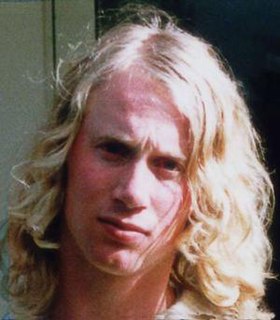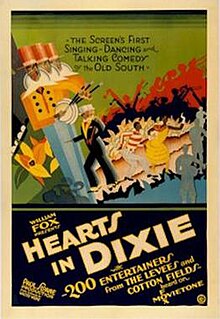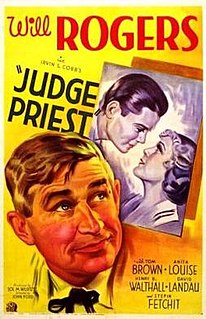
Lincoln Theodore Monroe Andrew Perry, better known by the stage name Stepin Fetchit, was an American vaudevillian, comedian, and film actor of Jamaican and Bahamian descent, considered to be the first black actor to have a successful film career. His highest profile was during the 1930s in films and on stage, when his persona of Stepin Fetchit was billed as the "Laziest Man in the World".

Calvary Cemetery is a Roman Catholic cemetery that the Archdiocese of Los Angeles runs in the community of East Los Angeles. It is also called "New Calvary Cemetery" because it succeeded the original Calvary Cemetery, over which Cathedral High School was built.

Simon Cameron was an American businessman and politician. He represented Pennsylvania in the United States Senate and served as United States Secretary of War under President Abraham Lincoln at the start of the American Civil War.

Martin John Bryant is a convicted Australian mass shooter who murdered 35 people and injured 23 others in the Port Arthur massacre, one of the world's deadliest shooting sprees, in Port Arthur, Tasmania, between 28 and 29 April 1996. He is concurrently serving 35 life sentences, plus 1,652 years, all without the possibility of parole, at Risdon Prison in Hobart.

Matthew Thomas Robinson Jr. was an American actor, writer and television producer. Robinson was the first actor to portray the character of Gordon Robinson on the PBS children's TV program Sesame Street. When Sesame Street began in 1969, not only did Robinson play Gordon, but he also provided the voice of the puppet Roosevelt Franklin and also was one of the show's producers. He left the show in 1972. In later years, when producers needed a last name for the Gordon character, then played by Hal Miller and then Roscoe Orman, they used Matt's last name.

Francis Xavier Aloysius James Jeremiah Keenan Wynn was an American character actor. His expressive face was his stock-in-trade; and though he rarely carried the lead role, he had prominent billing in most of his film and television roles.
The San Ysidro McDonald's massacre was an act of mass murder which occurred at a McDonald's restaurant in the San Ysidro neighborhood of San Diego, California, on July 18, 1984. The perpetrator, 41-year-old James Huberty, fatally shot 21 people and wounded 19 others before being killed by a police sniper approximately 77 minutes after he had first opened fire.
Theatre Owners Booking Association, or T.O.B.A., was the vaudeville circuit for African American performers in the 1920s. The theaters mostly had white owners, though there were exceptions, including the recently restored Morton Theater in Athens, Georgia, originally operated by "Pinky" Monroe Morton, and Douglass Theatre in Macon, Georgia owned and operated by Charles Henry Douglass. Theater owners booked jazz and blues musicians and singers, comedians, and other performers, including the classically trained, such as operatic soprano Sissieretta Jones, known as "The Black Patti", for black audiences.

James Edward "Pop" Pough was an American spree killer, who, on June 18, 1990, killed nine people and wounded four others in a GMAC car loan office in Jacksonville, Florida, before committing suicide. The day before, he had killed an innocent woman and man on Jacksonville’s Northside, wounded two teenagers, and robbed a convenience store.

David Richard Berkowitz, also known as the Son of Sam and .44 Caliber Killer, is an American serial killer who pleaded guilty to eight shootings that began in New York City on July 29, 1976.
Tison v. Arizona, 481 U.S. 137 (1987), is a United States Supreme Court case in which the Court qualified the rule it set forth in Enmund v. Florida (1982). Just as in Enmund, in Tison the Court applied the proportionality principle to conclude that the death penalty was an appropriate punishment for a felony murderer who was a major participant in the underlying felony and exhibited a reckless indifference to human life.

William Best, sometimes known as Sleep n' Eat, was an American television and film actor.

South Central Pennsylvania is a region of the U.S. state of Pennsylvania that includes the fourteen counties of Adams, Cumberland, Dauphin, Franklin, Huntingdon, Juniata, Lancaster, Lebanon, Mifflin, Perry, Snyder, and York. Portions of western Schuylkill and southern Northumberland counties are also located in South Central Pennsylvania. Despite the designation "South Central Pennsylvania," many of the counties are geographically located in the southeastern portion of the state. Lancaster, with a population of 59,322, is the largest city in the region, and the second largest metropolitan area. Harrisburg, with a population of 49,528, is the second largest city in the region, and has the largest metropolitan area with a population of 643,820 people, and is the capital of Pennsylvania. York is the other significant city in the region. The Harrisburg-Lancaster-York television market is the 39th largest market in the United States.

Hearts in Dixie (1929) starring Stepin Fetchit was one of the first all-"talkie", big-studio productions to boast a predominantly African-American cast. A musical, the film celebrates African-American music and dance. It was released by Fox Film Corporation just months before the release of Hallelujah!, another all-black musical by competitor Metro-Goldwyn-Mayer. The director of Hearts in Dixie was Paul Sloane. Walter Weems wrote the screenplay, and William Fox was producer.

Judge Priest is a 1934 American comedy film starring Will Rogers. The film was directed by John Ford, produced by Sol M. Wurtzel in association with Fox Film, and based on humorist Irvin S. Cobb's character Judge Priest. The picture is set in post-reconstruction Kentucky and the supporting cast features Henry B. Walthall, Hattie McDaniel and Stepin Fetchit. It was remade by Ford in 1953 as The Sun Shines Bright.
Mel Watkins is an American critic and author. A former staff member at The New York Times, he has written extensively about comedy and African-American literature and has often appeared as a commentator in television documentaries about entertainment history and performers such as Chris Rock and Richard Pryor.

William Howard Day was a black abolitionist, editor, educator and minister. After his father died when he was four, Day went to live with J.P. Williston and his wife who ensured that he received a good education and learned the printer's trade. He received his bachelor's and master's degree from Oberlin College. He was a printer and newspaper editor. He fought for civil rights of African Americans a number of ways, as a journalist, teacher, and leader of the Freedmen's Bureau. He was an orator, making a speech to 10,000 newly emancipated people on what biographer Todd Mealy called the first march on Washington.
On April 16, 2017, 74-year-old Robert Lee Godwin Sr. was shot and killed with a firearm while walking in the Glenville neighborhood of Cleveland, Ohio, United States. The perpetrator, identified as 37-year-old Steve Stephens, posted a cellphone video of the shooting on his Facebook account, leading many media outlets, both during the manhunt and afterward, to dub Stephens the "Facebook killer". A warrant was issued for Stephens for aggravated murder. Two days later, he died by a self-inflicted gunshot wound when cornered by police in Erie County, Pennsylvania.

A. C. Harris Bilbrew was an American poet, musician, composer, playwright, clubwoman, and radio personality known as Madame A. C. Bilbrew. She lived in South Los Angeles. In 1923, she became the first black soloist to sing on a Los Angeles radio program. She also hosted the city's first African-American radio music program, The Gold Hour, in the early 1940s. The A. C. Bilbrew branch of the LA County Library in Willowbrook was named in her honor.

African American cinema is loosely classified as films made by, for, or about Black Americans. Historically, African American films have been made with African-American casts and marketed to African-American audiences. The production team and director were sometimes also African American. More recently, Black films featuring multicultural casts aimed at multicultural audiences have also included American Blackness as an essential aspect of the storyline.















